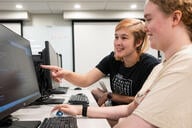You have /5 articles left.
Sign up for a free account or log in.
Fifty-five percent of students say a teaching style that didn’t work for them has impeded their success in a class since starting college. That makes it the No. 1 reported barrier to academic success in the recent Student Voice survey of 3,004 undergraduates on academic life, conducted in January by Inside Higher Ed and College Pulse. Here’s a breakdown of which students feel especially impacted by teaching style, why they may see this as a barrier and how active learning can help.
Disproportionately Dissatisfied
Among students with learning disabilities or related conditions (n=650):
- Teaching style is still the top reported barrier—with the share of students flagging it soaring to 67 percent. Of these students who intend to graduate within the standard time frame for their institution type (two or four years), the share is larger still: 70 percent.
- There is a strong desire for professors to experiment with different teaching styles. Fifty-seven percent of these students, versus 50 percent of those without learning disabilities or related conditions, express that professors mixing things up would help. Some five in 10 think that professors being more flexible about attendance and/or participation would promote their academic success, compared to four in 10 for all respondents.
Different demographic, similar story: Relatively more LGBTQIA+ students (n=899) cite teaching style as a barrier to academic success than do their straight peers, at 60 percent versus 53 percent, respectively. And LGBTQIA+ students are likelier to say they want professors to be more flexible with participation and attendance, at five in 10 versus four in 10.
Another consideration is mental health. Both LGBTQIA+ students and those with learning disabilities and related conditions are likelier than other subgroups to cite mental health struggles as a barrier to academic success: nearly six in 10 LGBTQIA+ students compared to three in 10 straight students and nearly six in 10 students with learning disabilities compared to three in 10 respondents without such conditions.
Breaking Down the Concern
What are students really saying when they object to teaching style? Students who cite teaching style as a barrier to a success are more likely to name overly difficult material or exams as another barrier (58 percent versus 49 percent for the whole group). So students may associate teaching style with how hard a class is or isn’t.
But students with teaching-style concerns are significantly likelier than the group over all to say they want their professors to experiment with different teaching approaches, too. This suggests that students concerned about teaching style are balking at instructional strategies at least as much as at perceived difficulty. (And this is only amplified for students with learning disabilities and related conditions, who, again, are already more likely to report mental health struggles as a barrier to academic success.)
Which instructional strategies? Research suggests that conventional lecturing remains the dominant instructional approach in higher education, especially in the natural sciences, where many of the studies on active learning are happening.
So it stands to reason that students in the recent Student Voice survey are at least partly rejecting conventional lecturing. Preliminary data from a new Student Voice survey of 1,250 undergraduates somewhat support this idea: the largest share of students (36 percent) say they prefer an interactive lecture—in which the professor breaks at least once to ask students to complete a specific learning task related to the material—over other class formats, including the traditional lecture. (Full results of that survey are coming soon.)
The Active Learning Link
What’s a better approach than traditional lecturing? The literature offers a clear answer: active learning.
Roughly defined, active learning is instruction that demands students actively participate in the knowledge-making process. Active learning exists on a spectrum—from a single interactive moment during a professor-centered class period to an entirely student-centered experience in which the instructor facilitates learning among peers. Examples of active learning strategies include:
- Classroom debates
- Class polls
- Case studies
- Think-pair-shares
- Individual reflection
- Just-in-time teaching
How students feel about active learning is a bit complicated. Anecdotally, many students find traditional lectures to be less than engaging. But active learning can defy students’ expectations of what’s required of them in a college class and push them out of their comfort zones. One widely cited 2019 study on active learning led by physicist Louis Deslauriers of Harvard University found that students in an active learning classroom felt like they were learning less but actually learned more than students in a lecture-only class—something Deslauriers and his colleagues attributed to the increased cognitive effort required during active learning.
Yet however students feel about active learning, study after study demonstrates that students learn more from active learning than from lectures—and that the positive effects of active learning are especially pronounced for historically marginalized groups.
“Sustained lecturing, or a chalk-and-talk approach, continues to be the dominant mode of instruction across all subject areas—which, as the survey data strongly indicate, leaves more than half of learners behind,” says Thomas J. Tobin, a teaching and learning consultant and founding member of the University of Wisconsin at Madison’s Center for Teaching, Learning & Mentoring. “The survey data about the perceived fit of instructor methods underlines a challenge that we’ve known about for a long time: our teaching methods have long been out of step with the learning needs of our students.”
Experts therefore recommend using active learning strategies to reach students dissatisfied with current instructional approaches—with some major caveats about sensitivities to student identities.
Inclusive Teaching
Sara Brownell, a professor of life sciences and director of the Research for Inclusive STEM Education Center at Arizona State University, studies how to make science learning environments more inclusive, with a focus on concealable, stigmatized identities. These include LGBTQIA+ identities and learning disabilities and related conditions. Brownell and her colleagues have found, for example, that:
- Students say clicker-style questions and group work during active learning can both increase and decrease their anxiety, based on how they’re used. Meanwhile, students say that cold- and random call–type questions only increase anxiety, based on fear of negative evaluation by peers.
- Active learning classes make students’ LGBTQIA+ identities more relevant due to increased interactions among students during group work, with implications for student learning.
How Sara Brownell, a professor at Arizona State who studies how to make science learning environments more inclusive, makes active learning inclusive in her own large classes:
- She surveys students about their identities at the beginning of the semester and shares anonymized patterns with the class, so that students with, say, mental health concerns, know they’re not alone.
- She uses what’s referred to as instructor talk, or non-content-specific language, to create a positive classroom culture and demystify some of her pedagogical choices, including her belief that group work builds students’ skills.
- She gives students name tents (paper name placards) so that she and they know each other’s names and, where they feel comfortable, pronouns.
- She gives small groups an icebreaker during active learning, such as directing the student with the longest hair in the group to speak first. And she travels around the classroom to speak with students and collect worksheets so that no one has to yell out an answer to the whole class.
Variety, flexibility and compassion underpin Brownell’s approach to active learning. “I’m a huge proponent of active learning, but our guiding hypothesis is that with active learning, we’re changing the dynamics of the classroom,” Brownell tells Inside Higher Ed. “So for different student groups that haven’t necessarily been explored through the lens of active learning, we’re starting to see issues for them. That doesn’t mean we want to throw active learning out the window. That doesn’t mean we want people to go back to traditional lecture. It means we need to be much more thoughtful about how we’re teaching using active learning.” Actions include, Brownell says:
- Using different active learning strategies so that all students get used to a variety of experiences, some of which they may prefer over others.
- Giving all students worksheets during group work, to promote engagement and discourage any one person taking over.
- Giving students the option of working with each other or working independently when they need a break.
- Incentivizing attendance via class credit, but building in “a certain number of drops, because life happens.”
- Normalizing mental health being as important as physical health by indicating support and being “kind” when things come up.
“I let my students know at the beginning of class that my goal is for them to succeed, and I am going to work as hard as I can to get them to learn the material,” she adds. “We know that feeling like the instructor cares is so important to student success.”
‘Listen to Students’
Dynamic teaching can work for neurodivergent students, with some clarifications, says Liz Norell, an associate professor of political science at Chattanooga State Community College and faculty developer who identifies as neurodivergent. Autistic students might have sensitivities around noise levels, lack of predictability or forced social interactions, for example. So options surrounding participation, such as “back-channel” ways to contribute class discussions, matter.
Norell has found that her students are most enthusiastic about learning when she’s given them more control or agency over their learning—namely, the work they’re completing and how it’s shared.
“A lot of this evolution in my own teaching has come from embracing [Universal Design for Learning] and backwards design—focusing really intentionally on what skills students should have when they leave a class I’m teaching and then imagining, in the broadest terms possible, how they might achieve those skills.”
Norell adds an important clarification on identities and diagnoses: that many students have mental health issues or are neurodivergent, “but haven’t had the resources or opportunities for formal testing or diagnosis and hence cannot get official accommodations from the school.” In this and other respects, she says, it’s important to “listen to students.”
Faculty developer Karen Costa, who is currently writing a book on supporting college students with attention deficit hyperactivity disorder, agrees that the accommodations model of higher education translates to a “huge population of students who need support who just aren’t getting it.” Accessibility should be “in the water,” or the norm, not the exception, she says.
Costa adds this: “Higher ed executive leaders are guided by enrollment numbers yet fail to see the connection between designing for accessibility and student persistence, strangely. The hold of the power structures in higher ed is very strong. Those who figure out that truly supporting students and faculty by redesigning our work for the students, faculty and staff we have now, not those of 400 years ago, will create the institutions that will survive this volatile era.”
Active (Inclusive) Learning: Good Teaching and Good Policy
In the Student Voice survey, Black, Hispanic, Asian and first-generation students were not more likely than their white peers to say to cite teaching style as a barrier to academic success, nor were they more likely to say they wanted professors to experiment with different teaching styles. Still, it’s worth underscoring that active learning has been shown to disproportionately benefit these students.
- One study from 2014 found that a “moderate-structure” intervention increased course performance for all students, but worked especially well for Black and first-generation students, halving the Black-white achievement gap and closing the achievement gap with continuing-generation students.
- Another meta-study from 2020 found that active learning benefits all students but offers disproportionate benefits for individuals from underrepresented groups.
The latter analysis showed that active learning reduced achievement gaps in examination scores by a third and narrowed gaps in passing rates by nearly half. Crucially, it also found that how much active learning students are doing matters, as only classes with high-intensity active learning narrowed achievement gaps.
The study further explains the variation in efficacy within active learning studies with a “heads-and-hearts hypothesis.” In other words, “meaningful reductions in achievement gaps only occur when course designs combine deliberate practice with inclusive teaching.”
Scott Freeman, teaching professor emeritus of biology at the University of Washington and co-author of the 2020 meta-study, says that there is still a disconnect between institutions’ commitments to diversity, equity and inclusion pledges and what’s known about how students learn.
“College campuses are just full of people very concerned about DEI, but then you go into your classrooms and they’re teaching in a way that’s just really punishing to low-income and Black and brown students,” Freeman says. “Institutions need to take the data seriously. If we hire people who are trained to do effective, evidence-based teaching and reward them, we can achieve equity and student outcomes. But the fact is, we’re not doing that.”
Regan Gurung, professor and director of the general psychology program at Oregon State University, who studies teaching and learning, doesn’t necessary like the term “teaching style,” due to its potential to reinforce the debunked notion that individual students have fixed or optimal ways of acquiring knowledge. (He actually addresses the invalid science behind learning styles with his classes each semester because he says the “myth” remains pervasive in K-12 schools.)
What is indisputable, though, Gurung says, is that “good teaching is inclusive teaching.” This means designing a course that is well structured, adopting evidence-based teaching practices and providing students with multiple ways to participate.
“When you’re thinking about teaching, you think about the student-student interaction. You think about the student-instructor interaction. And you think about the student-content interaction,” he says. “Whenever we’re thinking about course design, we should be saying, ‘What are we doing to help students interact with each other, with the material and with us?’”
Read more about Student Voice survey findings on what students want and don’t want from their professors. Share your feedback here.





